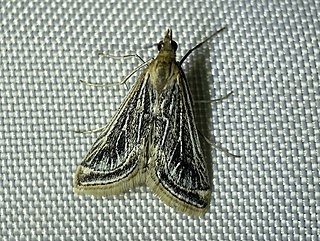
Donacaula is a genus of moths of the family Crambidae. The genus was erected by Edward Meyrick in 1890.
Elophila nebulosalis, the nebulous munroessa moth, is a moth in the family Crambidae. It was described by Charles H. Fernald in 1887. It is found in North America, where it has been recorded from South Carolina to Florida.
Epina alleni is a moth in the family Crambidae. It was described by Charles H. Fernald in 1888. It is found in North America, where it has been recorded from Indiana, Maine, Massachusetts, Pennsylvania and South Carolina.
Crambus multilinellus, the multinellus grass-veneer, is a moth in the family Crambidae. It was described by Charles H. Fernald in 1887. It is found in North America, where it has been recorded from Florida, Georgia, Illinois, Maryland, Minnesota, Mississippi, North Carolina, Ontario and South Carolina.
Loxocrambus coloradellus is a moth in the family Crambidae. It was described by Charles H. Fernald in 1893. It is found in North America, where it has been recorded from California and Colorado.
Neodactria zeellus is a moth in the family Crambidae. It was described by Charles H. Fernald in 1885. It is found in North America, where it has been recorded from Alberta, Florida, Indiana, Maine, Maryland, Massachusetts, Mississippi, Ohio, Oklahoma, Pennsylvania and Tennessee.
Thaumatopsis magnificus is a moth in the family Crambidae. It was described by Charles H. Fernald in 1891. It is found in North America, where it has been recorded from New Mexico, Arizona and Colorado.
Thopeutis forbesellus is a moth in the family Crambidae. It was described by Charles H. Fernald in 1896. It is found in North America, where it has been recorded in California, Illinois, Indiana, Louisiana, Maine, Maryland, Massachusetts, Minnesota, New Brunswick, Ohio, Ontario, Quebec and South Carolina.

Pyrausta inornatalis, the inornate pyrausta moth, is a moth in the family Crambidae. It was described by Charles H. Fernald in 1885. It is found in United States, where it has been recorded from Arizona, California, Florida, Arkansas, Kansas, Louisiana, Missouri, Oklahoma, Tennessee and Texas. It is also found in Mexico.

Pyrausta linealis is a moth in the family Crambidae. It was described by Charles H. Fernald in 1894. It is found in North America, where it has been recorded from eastern Washington to California and Nevada.
Donacaula albicostella is a moth in the family Crambidae. It was described by Charles H. Fernald in 1888. It is found in North America, where it has been recorded from Alberta, British Columbia, Manitoba, California, Connecticut, Illinois, Maine, Massachusetts, Michigan, Minnesota, New Jersey, Utah and Wisconsin.
Donacaula aquilella is a moth in the family Crambidae. It was described by James Brackenridge Clemens in 1860. It is found in North America, where it has been recorded from Alabama, Georgia, Massachusetts, Mississippi, New Jersey, New York, North Carolina and South Carolina.
Donacaula longirostrallus, the long-beaked donacaula moth, is a moth in the family Crambidae. It was described by James Brackenridge Clemens in 1860. It is found in North America, where it has been recorded from Nova Scotia, Ontario, Quebec, Alabama, Arkansas, Connecticut, Florida, Louisiana, Maine, Massachusetts, Michigan, Mississippi, Nebraska, New Jersey, New York, North Carolina, Pennsylvania, Texas, Vermont and Virginia.

Donacaula melinella is a moth in the family Crambidae. It was described by James Brackenridge Clemens in 1860. It is found in North America, where it has been recorded from Ontario, Alabama, Arizona, Arkansas, Connecticut, Delaware, Florida, Georgia, Illinois, Indiana, Kentucky, Louisiana, Maine, Maryland, Massachusetts, Michigan, Mississippi, Nebraska, New Jersey, New York, North Carolina, Pennsylvania, South Carolina, Texas and Virginia.
Donacaula nitidellus is a moth in the family Crambidae. It was described by Harrison Gray Dyar Jr. in 1917. It is found in North America, where it has been recorded from Alberta, Alabama, Connecticut, Georgia, Maryland, Massachusetts, Mississippi, New Jersey, New York, North Carolina, South Carolina and Texas.
Donacaula pallulellus is a moth in the family Crambidae. It was described by William Barnes and James Halliday McDunnough in 1912. It is found in North America, where it has been recorded from Alabama, Arizona, California, New York and Texas.
Donacaula sordidellus is a moth in the family Crambidae. It was described by Johann Leopold Theodor Friedrich Zincken in 1821. It is found in North America, where it has been recorded from Florida, Louisiana, Mississippi, Nebraska, New Jersey, New York, North Carolina, North Dakota, South Carolina and Texas.
Donacaula unipunctellus is a moth in the family Crambidae. It was described by Robinson in 1870. It is found in North America, where it has been recorded from Nova Scotia, Alabama, Florida, Georgia, Louisiana, Maine, Mississippi, New Jersey, New York, North Carolina, South Carolina, Texas, Utah and Virginia.
Leptosteges flavicostella is a moth in the family Crambidae. It was described by Charles H. Fernald in 1887. It is found in North America, where it has been recorded from Florida, South Carolina and Georgia.

Diasemiodes nigralis is a moth in the family Crambidae. It was described by Charles H. Fernald in 1892. It is found in North America, where it has been recorded from Florida to Texas, with strays north to at least Michigan and Maryland.




